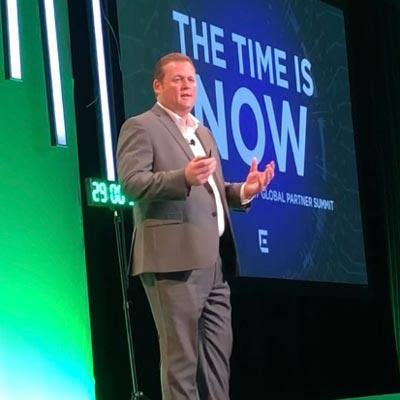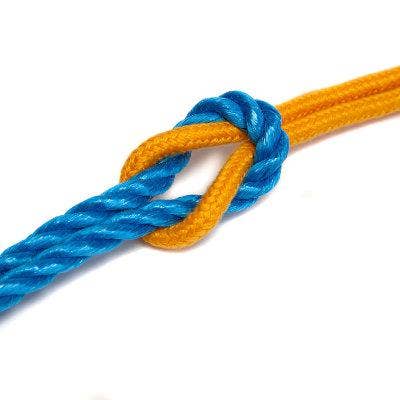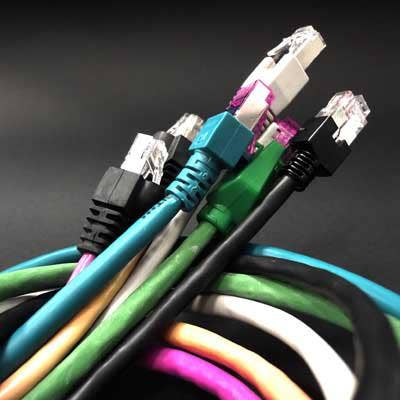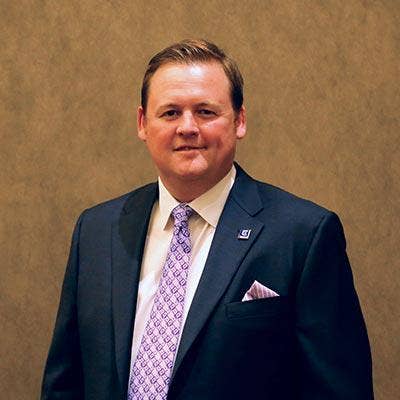10 Takeaways From Extreme Networks' 2017 Partner Summit

Going To Extremes
The slogan for the Extreme Networks Global Partner Summit this year was "The Time Is Now," and that's a message that resonated with Rob Huff, CEO of Extreme and Avaya partner STEP Communications Group. "Timing's everything, and their timing is perfect," Huff said. He was referring to Extreme's push to take on the biggest companies in the networking industry, through bringing together the networking businesses of Avaya, Brocade and Zebra under the Extreme Networks umbrella. During the Partner Summit this week in Orlando, Fla., Extreme—now the third-largest networking player with more than $1 billion in annual revenue—made the case for why it's moved out of the niche and into the mainstream. "It almost feels like a tipping point to me," said Extreme Channel Chief Gordon Mackintosh (pictured).
Partners who spoke with CRN agreed. "They have an opportunity to really disrupt the entire arena," Huff said. "They have the technology to do it, and they have the brains to do it."
What follows are our 10 biggest takeaways from attending Extreme's 2017 Global Partner Summit.

The New Product Portfolio Appears To Be Integrating Nicely
Extreme is bringing together a number of technologies -- Avaya's fabric technology, Brocade's data center solutions (including switching, routing and analytics) and Zebra's wireless LAN portfolio. Already, Extreme is offering an automated campus solution that fuses Avaya's fabric with Extreme's management technology. A new Wave 2 access point that can run either the ExtremeWireless or Zebra WiNG platform -- dubbed "SuperSpec" -- is also in the works. Integrations with Brocade's technology are next, following the impending closure of that acquisition.
Partners said they're impressed with what they've seen so far. Merging the Avaya fabric with Extreme's management and analytics "is just phenomenal" and should be a compelling package for many customers, said Dan Cox, chief technology officer at Cincinnati-based STEP Communications Group. While Avaya's fabric has been popular, the combination with the Extreme Management Center adds "the visibility we were missing," Cox said.
Overall, "the integration with the different manufacturers seems to be moving along very well," said David Rudnick, sales manager for Miami-based Extreme partner PC Solutions & Integration.

Extreme Learned From Past Mistakes Around Acquisitions
After Extreme acquired Enterasys in late 2013, the process of integrating the two companies didn't go as smoothly as it could've, Rudnick said. In 2015, Extreme ended up cutting 18 percent of its staff. ("It's kind of a mess over there right now," one partner told CRN at the time.) But the acquisitions from Zebra, Avaya and Brocade have gone much better, according to Rudnick. "You can tell just by the number of Brocade folks that are here," he said during the Partner Summit. "I think every acquisition they've done, each one's gone a little better. They're definitely learning." In particular, the way that sales territories are being divided up and the go-to-market strategy are much better with the recent acquisitions, Rudnick said. "I've seen almost no conflict," he said.

The New Channel Program Is An Improvement
Starting Jan. 1, Extreme plans to roll out a unified partner program for solution providers from all four companies, which emphasizes cross-selling, up-front discounts, simplification and attacking new verticals. "From what I've what seen, it's by far the most attractive channel program I've seen rolled out," Huff said. "They're doing some marketing funds, and they want to make sure to invest in the right partners -- there are loyalty clauses. They're also pushing us to cross-sell, which I think is brilliant."
Huff said his firm had been "struggling" a bit with operating as both an Extreme partner and an Avaya partner. "Extreme had their programs, Avaya had their programs. I wasn't too happy with the old Extreme programs. They did things differently -- Avaya did a lot of marketing funds on the front end, while Extreme did a lot of back-end rebates that were kind of like black magic sometimes," he said. "But now they came out with a program that really takes the best of both worlds, and really puts format to that. It's good. I'm very happy."

Cross-Selling Is A Key Opportunity
As mentioned, the "new" Extreme is aiming to inspire partners to sell additional products from the broadened portfolio. For instance, a partner that's just been selling Extreme products can go back to existing customers with Avaya's fabric or Brocade's data center solutions.
"What I love about the Brocade side is that now we have a router play with Extreme," said Rudnick, whose firm has partnered with Extreme since 2001. "It wasn't an addition of products that interfere with each other. It's adding additional products."
The same goes for partners that had predominantly sold products from the acquired business units. "We're looking at this as a huge opportunity to grow. Avaya struggled with wireless, they struggled with management," Huff said. "Now we're able to go back into these customers and really expand our reach within our customers and cross-sell the portfolio."

Extreme Is Now A Credible Contender With Cisco And HPE
In the past, Extreme was "always a niche player. It was always great products, great support. But it was niche," Rudnick said. "It didn't work for everyone, they didn't have a play for every client, they didn't have a play for every vertical." That's no longer the case with the new Extreme, he said.
Partners now have a strong shot at selling Extreme to customers who currently use Cisco or HPE for their networking, Huff said. "We are getting seats at the table with individuals that would've never even met with us six months ago," he said.
Previously, Extreme was "not big enough … But now, [customers] have to see what's going on," Huff said. "With the technology that they have right now, if you get a seat at that table -- and if you look at total cost of ownership and you give us a real shot -- we will win 90 percent of the time."
In an interview with CRN, Extreme CEO Ed Meyercord said that a "very large logistics company" that has half Extreme WiNG and half Cisco products on its wireless edge is "actively displacing the remaining Cisco with Extreme."

A Main Critique Of Competitors: They're Not Focused On Networking
Meyercord told CRN that in the enterprise networking market, Extreme is "the only player that's truly focused on networking. Cisco and HPE are in the market. But they're in all the markets."
With Cisco, "you hear them talking about servers, security solutions around servers and applications. They're talking about storage, security around storage. And then hyper-converged solutions. They're trying to play in hype-scale cloud. They're trying to be in service provider networks. They're playing everywhere in networking, but they're also in these other markets," Meyercord said. "So what's kind of interesting is, if you're not focused, you kind of take your eye off the ball. And the same is true with HPE -- they're just not as focused as we are in networking."

The Acquisitions Should Open Up New Verticals For Many Partners
The addition of networking products from Avaya, Zebra and Brocade means that Extreme is now a stronger player in a number of verticals, such as federal government and retail, according to Extreme executives and partners. Both Avaya and Brocade have a major presence in the federal space, which should be an "absolutely huge" opportunity for partners, Extreme Chief Marketing Officer Norman Rice told CRN in an interview. In federal, "we never had a formidable portfolio for a partner to engage with Extreme" until now, Rice said.
Meanwhile, Huff said Extreme's WiNG access points are a terrific fit for the retail segment, and his firm is now aiming to do more business in retail. "It gives us the opportunity to really grow our revenues organically within our client base," he said.

Extreme Execs Think They've Passed A Tipping Point
In an interview with CRN, Mackintosh said he spoke with a number of partners that sell different brands of networking technology, but "are now thinking about standardizing their business more on Extreme." The talk of standardizing on Extreme at the summit was "way more than I had dreamt about, actually," he said.
"It almost feels like a tipping point to me," Mackintosh said. "We've been in the background, we've had some opportunities in certain verticals with some very loyal partners, and now the tipping point is that we're moving into the mainstream."

IoT Is A Chief Opportunity Going Forward
Meyercord said the Internet of Things is a natural fit for Extreme's technology. "If you talk to any hospital CIO, they're going to say we've been in IoT forever. Because in a hospital, everything's connected to the network. ... As we look at IoT, it's a further extension -- more machines and devices like pumps that will be coming on the network," he said. "And so having the capacity for that is something that we're very well-positioned for. We think it's going to be a greater magnitude -- I don't want to suggest that we're not further developing our software to handle more devices. We are -- but in a way we've already been doing that."
Huff said that in IoT, "it all comes down to management and simplicity, and that's really what [Extreme] brings to market. Their analytics, so that you know what's going on in your infrastructure- - what are all these sensors doing. That's where Extreme is going to really separate themselves in the IOT world."

There's Plenty Of Excitement In The Partner Ranks Right Now
Rudnick said that in a decade and a half of partnering with Extreme, this is "by far" the most momentum he's ever seen for the company. Huff agreed, saying the evolution of Extreme "feels right."
"I think that the focus is well-invited by the entire community. I'm excited that they're keeping all of the portfolio alive. Their direction is very concise, which is important," he said. "I'm really excited. I'm really bullish on potential growth."